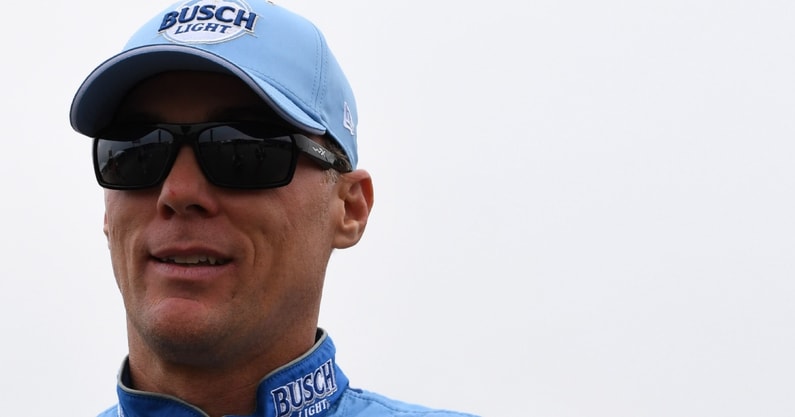Kevin Harvick responds to whether Talladega delivered as 'traditional' NASCAR superspeedway race

Kevin Harvick watched as the NASCAR Cup Series took their Round of 8 to Talladega. After Chase Briscoe’s thrilling win, the former champion offered up his insight on how the race stacked up to the sport’s storied superspeedway tradition.
Via the latest Kevin Harvick’s Happy Hour, Harvick broke down the dynamics of Sunday’s event. While he praised the finish, he noted some unhappiness with how fuel strategy shaped the early stages of the event in Alabama.
“I think it’s been what we’ve seen,” Harvick explained. “I think that if I had turned it on with 25 laps to go, I’d have been like, ‘Man, that was a badass race.’ But I think that the fuel mileage and all the things that happened in the beginning of the races just make it different.
“There were drivers saving and not saving and people backing the pace up. At the end it was very exciting to watch and very intense for the way that the race finishes. Now, I understand that there are moments that lead up to getting towards the finish and the drivers all know how to get to the finish, and there was Kyle Larson running out of gas at the end of the race.
“That really broke that bottom line up and allowed Chase Briscoe to get underneath Bubba Wallace right there, with his teammate tucked in right behind him and Ty Gibbs. They were able to get themselves organized and get to the start-finish line first. So just a great finish.”
Harvick certainly applauded the thrilling closing laps, but it’s evident he believes NASCAR still needs to address superspeedway racing as a whole. He questioned whether changes to stage breaks could help eliminate the mid-race “fuel mileage” lulls that have altered how drivers approach these events.
“I think that there’s definitely some things that need to happen with superspeedway racing that allow us to see what we saw at Daytona,” Harvick said. “Do we need another stage? What do we need to do to break up all the fuel mileage stuff to have those lulls in the middle of the race to get rid of those?
“I think the rules should change constantly with the superspeedway cars to keep the teams evolving, to keep the competition mixed up. I do think that the Fords lost a little bit of their advantage compared to the Chevys and the Toyotas this time around. As we keep going with the same rules, things become more and more even. And then it becomes about strategy.
“So I’m a big fan of keeping the rules mixed up at the superspeedways. I still don’t like the fact that you can push as hard as they can push and not get more rewarded for it. I don’t know how we fix that problem of when the two cars get connected, that it’s a bigger difference of speed than what it is right now.
Top 10
- 1New
Michael Taaffee
Texas DB has surgery
- 2Hot
SEC fines Texas A&M
Faking injuries is costly
- 3
Tony Vitello
Vols coach spotted at scrimmage
- 4
UF Coaching Search
Two non-Kiffin names to watch
- 5Trending
Steve Spurrier
Reacts to Kiffin, Florida talk
Get the Daily On3 Newsletter in your inbox every morning
By clicking "Subscribe to Newsletter", I agree to On3's Privacy Notice, Terms, and use of my personal information described therein.
“But the amount of time that they spend pushing and shoving to not have it be mixed up more isn’t how it needs to be, isn’t how you want superspeedway racing to be. You want to be able to go from the back to the front and not get, when they’re all going, it’s two lanes until they decide to fan out and try to make those moves at the end of the race.
“If those moves only last for a lap or two when people are going and trying to get their final position, for the most part, it winds up double file, two lanes, and they’re pushing like crazy and not able to get broken away from a lane. I just wish we could understand what we need to do to get those pushes to be more rewarding.”
Continuing, Harvick touched on the intensity of the pack racing itself, saying that the aggressive nature of the current package contributes to many of the wrecks fans see late in races, especially late in the race. The dynamics often create chain reactions that take out drivers through no direct fault of their own, or even the car right behind them.
“You have to push really hard, which is why we see most of the wrecks,” Harvick said. “Because, you know, even when we saw the No. 17 car of Chris Buescher get spun out, that didn’t happen from the guy right behind him — that happened from the guy that was pushing the second car in line. William Byron was probably off the brake and off the gas, and the guy behind him and all the momentum from that line just shoved him forward.
“I mean, that should be a massive advantage to that line. So we’ve got to be able to figure out how to make the intensity of the pushes mean more with the speed gain in the cars that are happening, because they just get locked into that double-file racing. But it’s awful late to make a change when it’s already the end of October to get to the Daytona 500.”
All told, Harvick’s assessment reflects the balance NASCAR faces at their biggest tracks. The 2014 champion is trying to figure out how to preserve the thrill of superspeedway racing while evolving with the times, as it’s far from perfect at the moment.